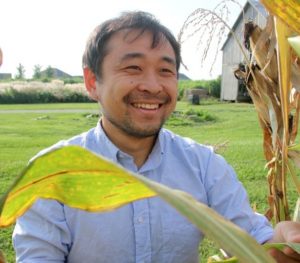
Kaiyu Guan is an Assistant Professor in ecohydrology and geoinformatics at the University of Illinois at Urbana Champaign.
Researchers are using the Blue Waters supercomputer to create better tools for long-Term crop prediction.
NCSA Professor Kaiyu Guan and NCSA postdoc fellow, Bin Peng have implemented and evaluated a new maize growth model. The CLM-APSIM model combines superior features in both Community Land Model (CLM) and Agricultural Production Systems sIMulator (APSIM), creating one of the most reliable tools for long-term crop prediction in the U.S. corn belt. Peng and Guan recently published their paper, “Improving maize growth processes in the community land model: Implementation and evaluation” in the Agricultural and Forestry Meteorology journal. This work is an outstanding example of the convergence of simulation and data science that is a driving factor in the National Strategic Computing Initiative announced by the White House in 2015.
One class of crop models is agronomy-based and the other is embedded in climate models or earth system models. They are developed for different purposes and applied at different scales,” says Guan. “Because each has its own strengths and weaknesses, our idea is to combine the strengths of both types of models to make a new crop model with improved prediction performance.” Additionally, what makes the new CLM-APSIM model unique is the more detailed phenology stages, an explicit implementation of the impacts of various abiotic environmental stresses (including nitrogen, water, temperature and heat stresses) on maize phenology and carbon allocation, as well as an explicit simulation of grain number.
With support from the NCSA Blue Waters project (funded by the National Science Foundation and Illinois), NASA and the USDA National Institute of Food and Agriculture (NIFA) Foundational Program, Peng and Guan created the prototype for CLM-APSIM. “We built this new tool to bridge these two types of crop models combining their strengths and eliminating the weaknesses.”
The team is currently conducting a high resolution regional simulation over the contiguous United States to simulate corn yield at each planting corner. “There are hundreds of thousands of grids, and we run this model over each grid for 30 years in historical simulation and even more for future projection simulation,” said Peng, “currently it takes us several minutes to calculate one model-year simulation over a single grid. The only way to do this in a timely manner is to use parallel computing with thousands of cores in Blue Waters.”

Conceptual diagram for phenological stages in the original CLM, APSIM and CLM-APSIM models. Unique features in CLM-APSIM crop model are also highlighted. Note that the stage duration in this diagram is not proportional to real stage length, and only presented for illustrative purpose.
Peng and Guan examined the results of this tool at seven different locations across the U.S. Corn Belt, revealing that the CLM-APSIM model more accurately predicted and simulated phenology of leaf area index (LAI) and canopy height, surface fluxes including gross primary production, net ecosystem exchange, latent heat, sensible heat and especially in simulating the biomass partition and maize yield in comparison to the earlier CLM4.5 model. The CLM-APSIM model also corrected a serious deficiency in the original CLM model that underestimated aboveground biomass and overestimated the Harvest Index, which led to a reasonable yield estimation with wrong mechanisms.
Additionally, results from a 13-year simulation (2001-2013) at three sites located in Mead, NE, (US-Ne1, Ne2 and Ne3) show that the CLM-APSIM model can more accurately reproduce maize yield responses to growing season climate (temperature and precipitation) than the original CLM4.5 when benchmarked with the site-based observations and USDA county-level survey statistics.
We can simulate the past, because we already have the weather datasets, but looking into the next 50 years, how can we understand the effect of climate change? Furthermore, how can we understand what farmers can do to improve and mitigate the climate change impact and improve the yield?” Guan said.

Bin Peng is a postdoctoral research associate at NCSA.
Their hope is to integrate satellite data into the model, similar to that of weather forecasting. “The ultimate goal is to not only have a model, but to forecast in real-time, the crop yields and to project the crop yields decades into the future,” said Guan. “With this technology, we want to not only simulate all the corn in the county of Champaign, Illinois, but everywhere in the U.S. and at a global scale.”
From here, Peng and Guan plan to expand this tool to include other staple crops, such as wheat, rice and soybeans. They are projected to complete a soybean simulation model for the entire United States within the next year.




